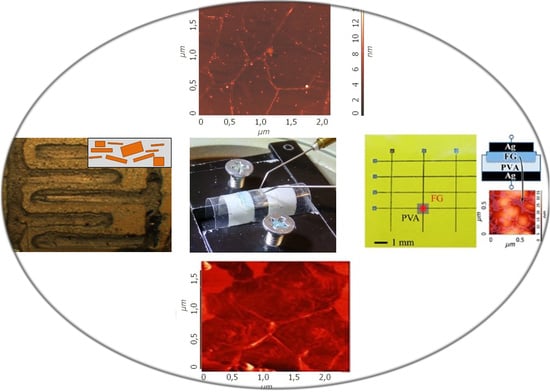Flexibility of Fluorinated Graphene-Based Materials
Abstract
1. Introduction
2. Experimental Methods
2.1. Fluorination of CVD Grown Graphene and Multilayer Graphene
2.2. Preparation of Fluorinated Graphene Suspensions
3. Results and Discussion
3.1. CVD Grown Graphene and Multilayer Graphene Films
3.2. Films Created from FG Suspension
3.3. FG films in Two-Layer Memristor Structures
4. Discussion
5. Conclusions
Author Contributions
Acknowledgments
Conflicts of Interest
References
- Zhu, W.; Park, S.; Yogeesh, M.; Akinwande, D. Advancements in 2D flexible nanoelectronics: From material perspectives to RF applications. Flex. Print. Electron. 2017, 2, 043001. [Google Scholar] [CrossRef]
- Singh, E.; Meyyappan, M.; Nalwa, H.S. Flexible graphene-based wearable gas and chemical sensors. ACS Appl. Mater. Interfaces 2017, 9, 34544. [Google Scholar] [CrossRef] [PubMed]
- Lipani, L.; Dupont, B.G.R.; Doungmene, F.; Marken, F.; Tyrrell, R.M.; Guy, R.H.; Ilie, A. Non-invasive, transdermal, path-selective and specific glucose monitoring via a graphene-based platform. Nat. Nanotechnol. 2018, 13, 504. [Google Scholar] [CrossRef] [PubMed]
- Ameri, S.K.; Ho, R.; Jang, H.; Tao, L.; Wang, Y.; Wang, L.; Schnyer, D.M.; Akinwande, D.; Lu, N. Graphene electronic tattoo sensors. ACS Nano 2017, 11, 7634. [Google Scholar] [CrossRef] [PubMed]
- Chen, G.; Zhang, P.; Pan, L.; Qi, L.; Yu, F.; Gao, C. Flexible nonvolatile resistive memory devices based on SrTiO3 nanosheets and polyvinylpyrrolidone composites. J. Mater. Chem. C 2017, 5, 9799. [Google Scholar] [CrossRef]
- Kim, S.J.; Choi, K.; Lee, B.; Kim, Y.; Hong, B.H. Stretchable electronics: Graphene and 2D materials. Annu. Rev. Mater. Res. 2015, 45, 63. [Google Scholar] [CrossRef]
- Chen, Y.; Xu, B.; Wen, J.; Gong, J.; Hua, T.; Kan, C.-W.; Deng, J. Design of novel wearable, stretchable, and waterproof cable-type supercapacitors based on high-performance nickel cobalt sulfide-coated etching-annealed yarn electrodes. Small 2018, 14, 1704373. [Google Scholar] [CrossRef] [PubMed]
- Pang, S.; Gao, Y.; Choi, S. Flexible and stretchable biobatteries: Monolithic integration of membrane-free microbial fuel cells in a single textile layer. Adv. Energy Mater. 2017, 8, 1702261. [Google Scholar] [CrossRef]
- Alonso, E.T.; Rodrigues, D.P.; Khetani, M.; Shin, D.-W.; Sanctis, A.D.; Joulie, H.; Schrijver, I.; Baldycheva, A.; Alves, H.; Neves, A.I.S.; et al. Graphene electronic fibres with touch-sensing and light emitting functionalities for smart textiles. Flex. Electron. 2018, 2, 25. [Google Scholar] [CrossRef]
- Park, M.; Bok, B.-G.; Ahn, J.-H.; Kim, M.-S. Recent advances in tactile sensing technology. Micromachines 2018, 9, 321. [Google Scholar] [CrossRef]
- Akinwande, D.; Petrone, N.; Hone, J. Two-dimensional flexible nanoelectronics. Nat. Commun. 2014, 5, 5678. [Google Scholar] [CrossRef] [PubMed]
- Falin, A.; Cai, Q.; Santos, E.J.G.; Scullion, D.; Qian, D.; Zhang, R.; Yang, Z.; Huang, S.; Watanabe, K.; Taniguchi, T.; et al. Mechanical properties of atomically thin boron nitride and the role of interlayer interactions. Nat. Commun. 2017, 8, 15815. [Google Scholar] [CrossRef] [PubMed]
- Carey, T.; Cacovich, S.; Divitini, G.; Ren, J.; Mansouri, A.; Kim, J.M.; Wang, C.; Ducati, C.; Sordan, R.; Torrisi, F. Fully inkjet-printed two-dimensional material field-effect heterojunctions for wearable and textile electronics. Nat. Commun. 2017, 81, 202. [Google Scholar] [CrossRef] [PubMed]
- Petrone, N.; Chari, T.; Meric, I.; Wang, L.; Shepard, K.L.; Hone, J. Flexible graphene field-effect transistors encapsulated in hexagonal boron nitride. ACS Nano 2015, 9, 8953. [Google Scholar] [CrossRef] [PubMed]
- Antonova, I.V.; Kotin, I.A.; Kurkina, I.I.; Ivanov, A.I.; Yakimchuk, E.A.; Nebogatikova, N.A.; Vdovin, V.I.; Gutakovskii, A.K.; Soots, R.A. Graphene/fluorinated graphene systems for a wide spectrum of electronics application. J. Mater. Sci. Eng. 2017, 6, 1000379. [Google Scholar]
- Antonova, I.V.; Kurkina, I.I.; Gutakovskii, A.K.; Kotin, I.A.; Ivanov, A.I.; Nebogatikova, N.A.; Soots, R.A.; Smagulova, S.A. Fluorinated graphene suspension for flexible and printed electronics: Flakes, films, and heterostructures. Mater. Des. 2019, 164, 107526. [Google Scholar] [CrossRef]
- Ho, K.-I.; Boutchich, M.; Su, C.-Y.; Moreddu, R.; Marianathan, E.S.R.; Montes, L.; Lai, C.-L. A Self-Aligned High-Mobility Graphene Transistor: Decoupling the Channel with Fluorographene to Reduce Scattering. Adv. Mater. 2015, 27, 6519. [Google Scholar] [CrossRef]
- Ho, K.-I.; Huang, C.-H.; Liao, J.-H.; Zhang, W.; Li, L.-J.; Lai, C.-S.; Su, C.-Y. Fluorinated Graphene as High Performance Dielectric Materials and the Applications for Graphene Nanoelectronics. Sci. Rep. 2014, 4, 5893. [Google Scholar] [CrossRef]
- Zhao, J.; Zhang, G.-Y.; Shi, D.-X. Review of graphene-based strain sensors. Chin. Phys. B 2013, 22, 057701. [Google Scholar] [CrossRef]
- Kim, K.S.; Zhao, Y.; Jang, H.; Lee, S.Y.; Kim, J.M.; Kim, K.S.; Ahn, J.-H.; Kim, P.; Choi, J.-Y.; Hong, B.H. Large-scale pattern growth of graphene films for stretchable transparent electrodes. Nature 2009, 45, 7706. [Google Scholar] [CrossRef]
- Cocco, G.; Cadelano, E.; Colombo, L. Gap opening in graphene by shear strain. Phys. Rev. B 2010, 81, 241412. [Google Scholar] [CrossRef]
- Androulidakis, C.; Koukaras, E.N.; Parthenios, J.; Kalosakas, G.; Papagelis, K.; Galiotis, C. Graphene flakes under controlled biaxial deformation. Sci. Rep. 2015, 5, 18219. [Google Scholar] [CrossRef] [PubMed]
- Gong, L.; Young, R.J.; Kinloch, I.A.; Riaz, I.; Jalil, R.; Novoselov, K.S. Optimizing the reinforcement of polymer-based nanocomposites by graphene. ACS Nano 2012, 6, 2086. [Google Scholar] [CrossRef] [PubMed]
- Choi, S.M.; Jhi, S.-H.; Son, Y.-W. Effects of strain on electronic properties of graphene. Phys. Rev. B 2010, 81, 081407. [Google Scholar] [CrossRef]
- Nair, R.R.; Ren, W.C.; Jalil, R.; Riaz, I.; Kravets, V.G.; Britnell, L.; Blake, P.; Schedin, F.; Mayorov, A.S.; Yuan, S.; et al. Fluorographene: Two dimensional counterpart of teflon. Small 2010, 6, 2877. [Google Scholar] [CrossRef]
- Lee, C.; Wai, X.; Kysar, J.W.; Home, J. Measurement of the elastic properties and intrinsic strength of monolayer graphene. Science 2008, 321, 385. [Google Scholar] [CrossRef]
- Nebogatikova, N.A.; Antonova, I.V.; Volodin, V.A.; Prinz, V.Y. Functionalization of graphene and few-layer graphene with aqueous solution of hydrofluoric acid. Physica E 2013, 52, 106. [Google Scholar] [CrossRef]
- Nebogatikova, N.A.; Antonova, I.V.; Prinz, V.Y.; Kurkina, I.I.; Aleksandrov, G.N.; Timofeev, V.B.; Smagulova, S.A.; Zakirov, E.R.; Kesler, V.G. Fluorinated graphene dielectric films obtained from functionalized graphene suspension: Preparation and properties. Phys. Chem. Chem. Phys. 2015, 17, 13257. [Google Scholar] [CrossRef]
- Lee, J.; Tao, L.; Parrish, K.N.; Hao, Y.; Ruoff, R.S. Akinwande D. Multi-finger flexible graphene field effect transistors with high bendability. Appl. Phys. Lett. 2012, 101, 252109. [Google Scholar] [CrossRef]
- Ivanov, A.I.; Nebogatikova, N.A.; Kotin, I.A.; Antonova, I.V.; Smagulova, S.A. Threshold resistive switching effect in fluorinated graphene films with graphene quantum dots enhanced by polyvinyl alcohol. Nanotechnology 2019, 30, 255701. [Google Scholar] [CrossRef]
- Jin, C.H.; Lan, H.P.; Peng, L.M.; Suenaga, K.; Iijima, S. Raman Mapping Investigation of Graphene on Transparent Flexible Substrate: The Strain Effect. Phys. Rev. Lett. 2009, 102, 205501. [Google Scholar] [CrossRef]
- Yoon, D.; Son, Y.W.; Cheong, H. Strain-Dependent Splitting of the Double-Resonance Raman Scattering Band in Graphene. Phys. Rev. Lett. 2011, 106, 155502. [Google Scholar] [CrossRef]
- Mohiuddin, T.M.G.; Lombardo, A.; Nair, R.R.; Bonetti, A.; Savini, G.; Jalil, R.; Bonini, N.; Basko, D.M.; Galiotis, C.; Marzari, N.; et al. Uniaxial strain in graphene by Raman spectroscopy: G peak splitting, Grüneisen parameters, and sample orientation. Phys. Rev. B 2009, 79, 205433. [Google Scholar] [CrossRef]

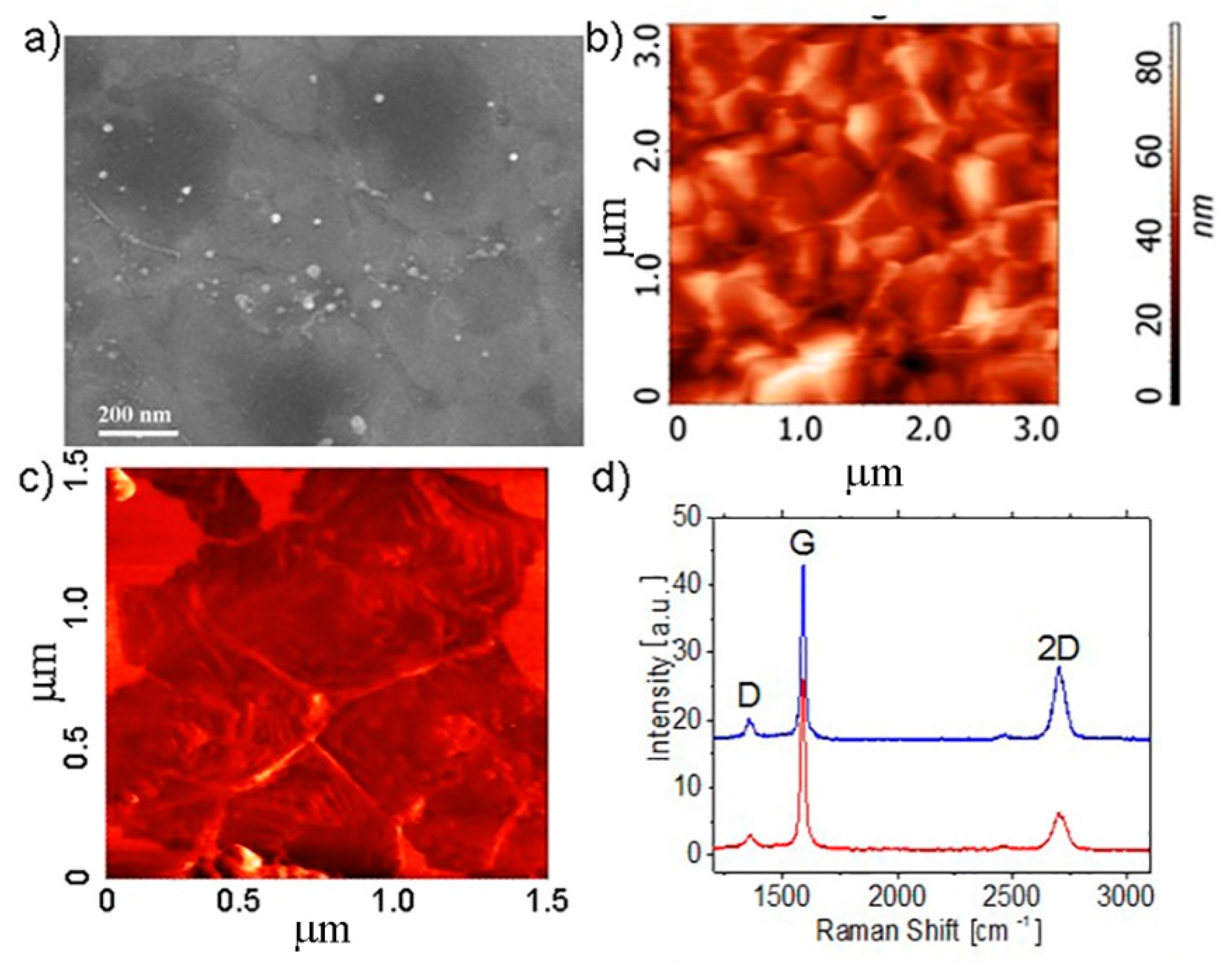
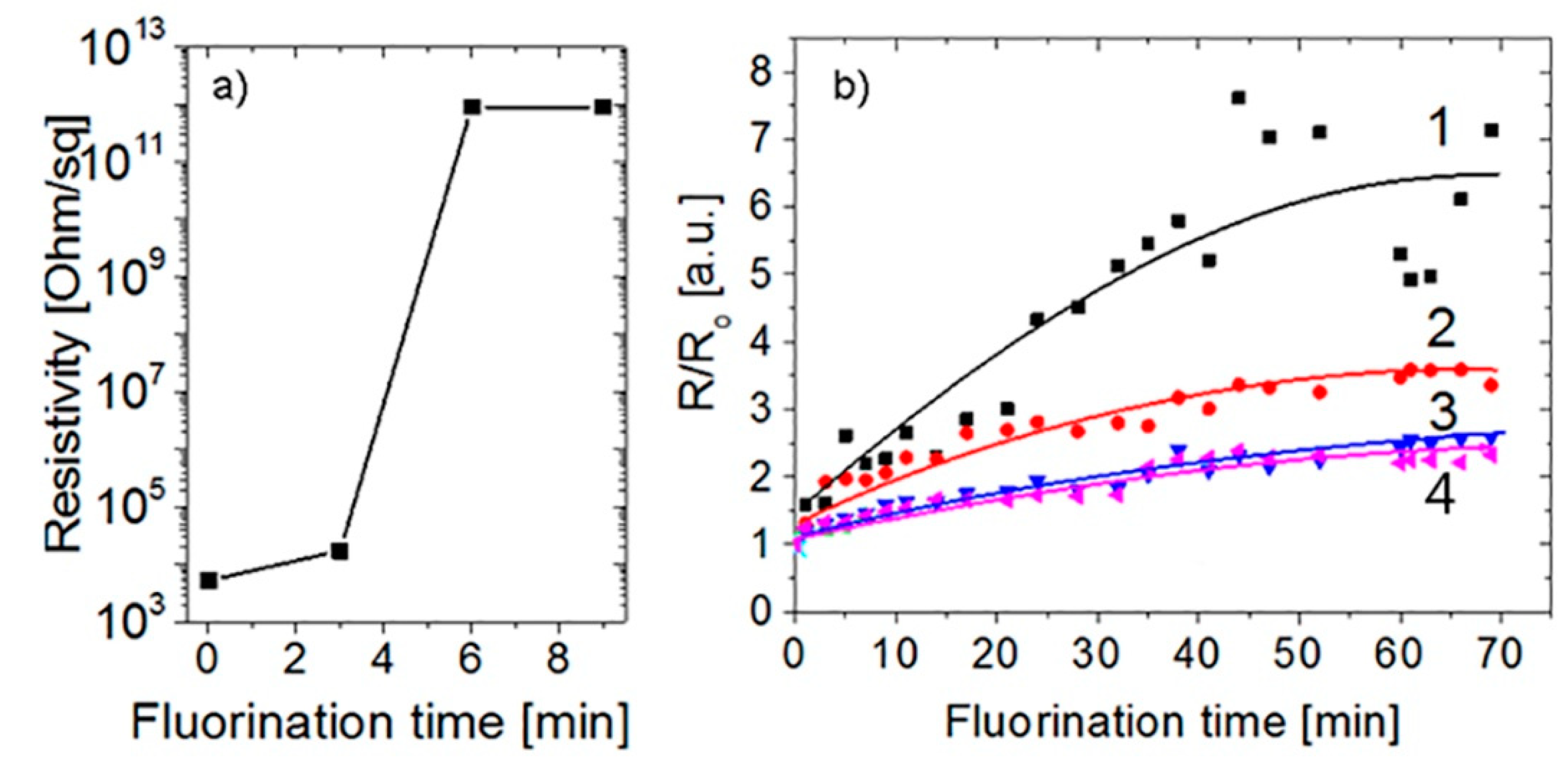
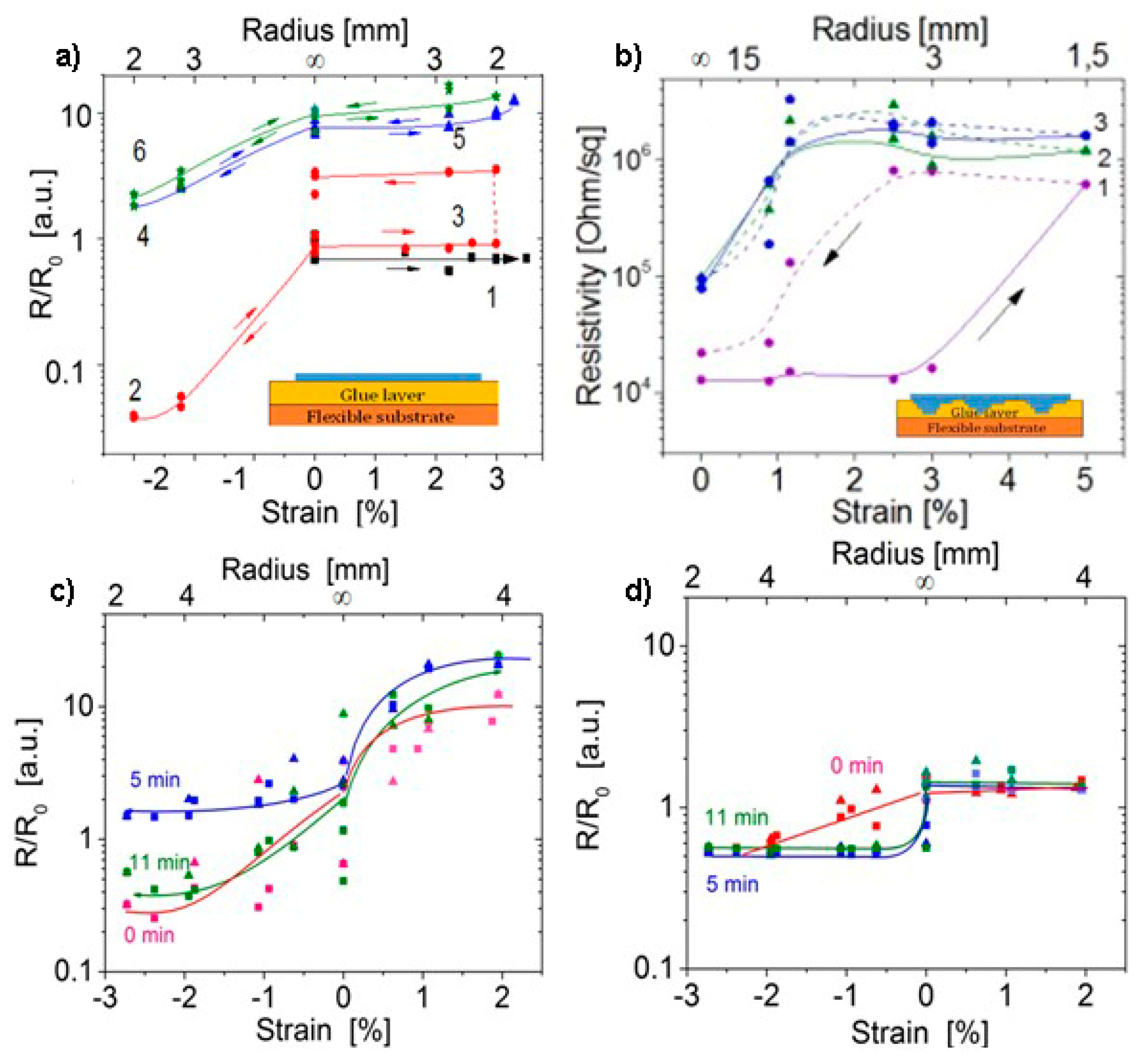
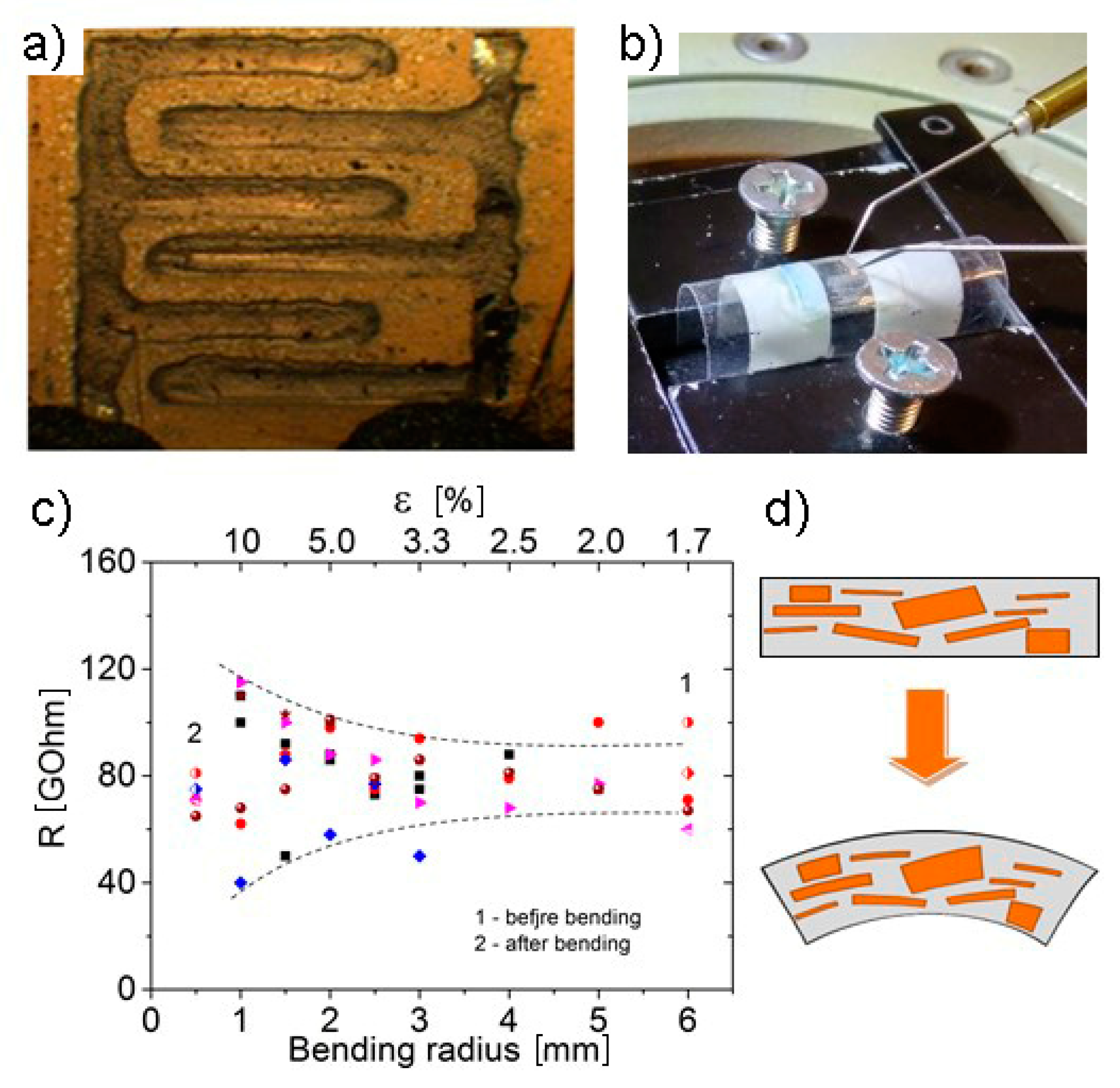
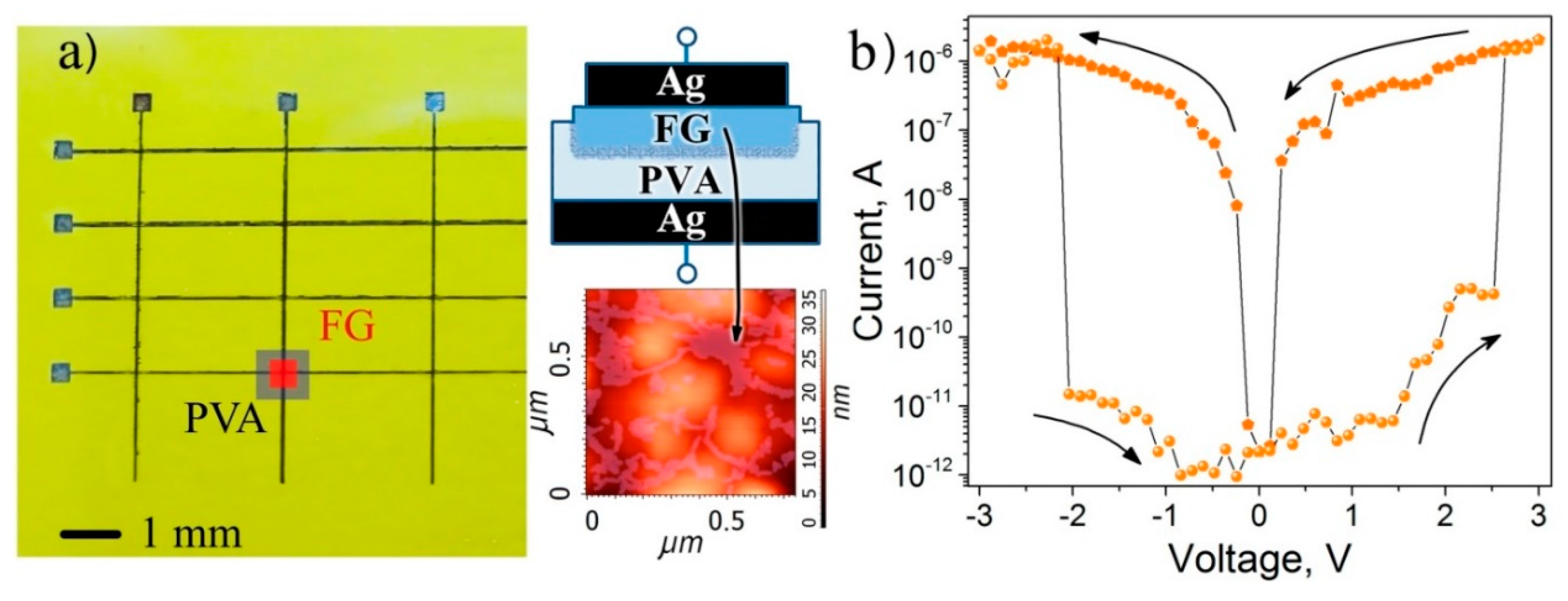
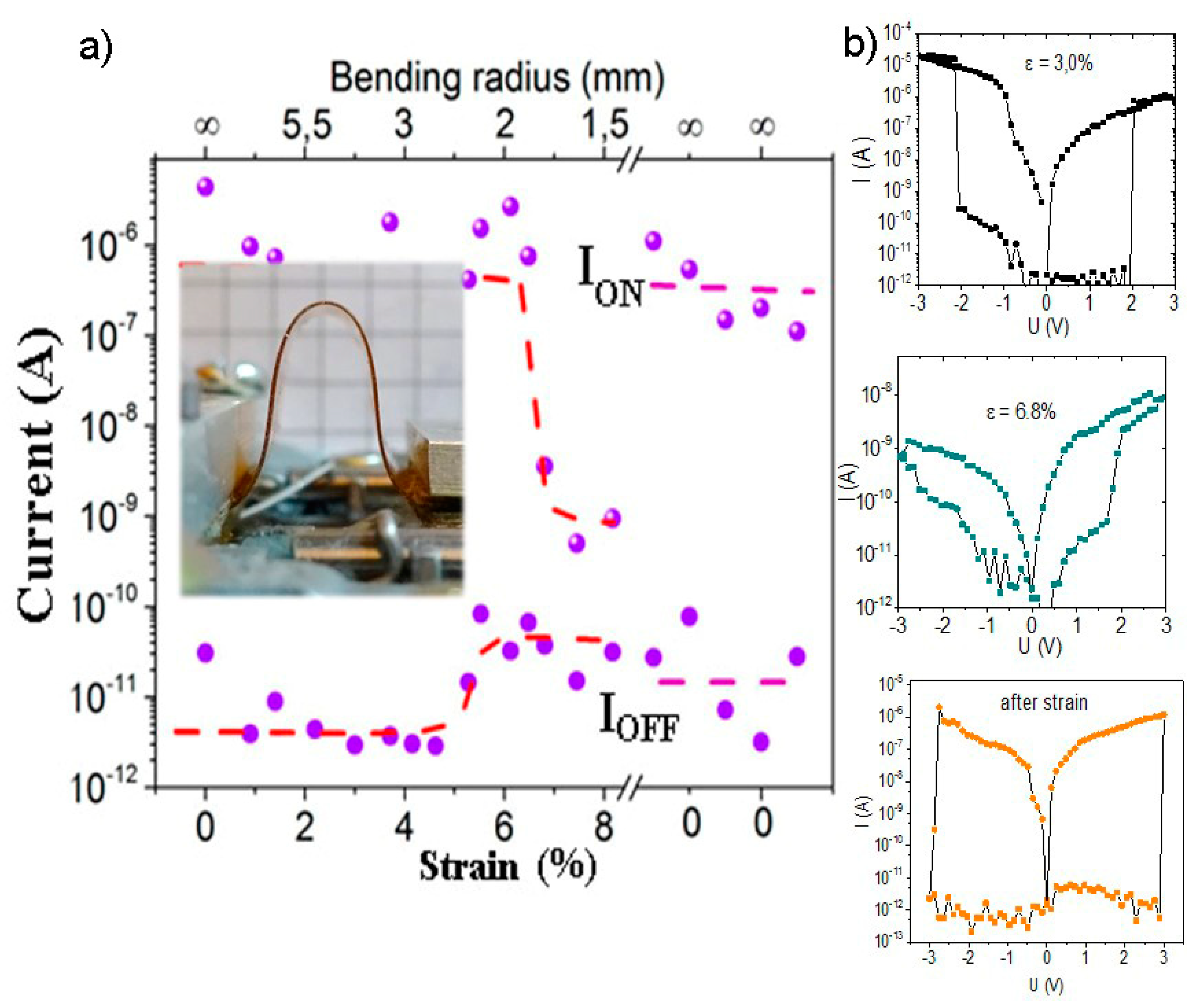

© 2020 by the authors. Licensee MDPI, Basel, Switzerland. This article is an open access article distributed under the terms and conditions of the Creative Commons Attribution (CC BY) license (http://creativecommons.org/licenses/by/4.0/).
Share and Cite
Antonova, I.; Nebogatikova, N.; Zerrouki, N.; Kurkina, I.; Ivanov, A. Flexibility of Fluorinated Graphene-Based Materials. Materials 2020, 13, 1032. https://doi.org/10.3390/ma13051032
Antonova I, Nebogatikova N, Zerrouki N, Kurkina I, Ivanov A. Flexibility of Fluorinated Graphene-Based Materials. Materials. 2020; 13(5):1032. https://doi.org/10.3390/ma13051032
Chicago/Turabian StyleAntonova, Irina, Nadezhda Nebogatikova, Nabila Zerrouki, Irina Kurkina, and Artem Ivanov. 2020. "Flexibility of Fluorinated Graphene-Based Materials" Materials 13, no. 5: 1032. https://doi.org/10.3390/ma13051032
APA StyleAntonova, I., Nebogatikova, N., Zerrouki, N., Kurkina, I., & Ivanov, A. (2020). Flexibility of Fluorinated Graphene-Based Materials. Materials, 13(5), 1032. https://doi.org/10.3390/ma13051032





